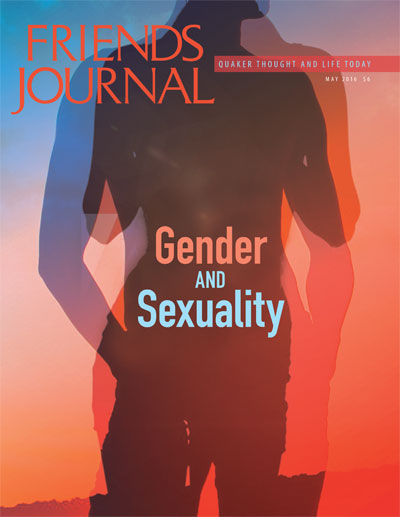
Rufus Jones’s Maine accent, I’ll never be able to imitate that. I don’t look anything like the famous Quaker writer and unifier, either. Jones was born in 1863, I in 1968; a momentous span of humanity separates our earthly lives.
Yet in 2015, in three Indiana Quaker meetinghouses and churches, I became Rufus Jones. I wore a vintage (and somewhat uncomfortable) suit, small wire-rim glasses, and a pocket watch on a chain. It started as a quirky Quaker history lesson in my semi-programmed meeting, Indianapolis First Friends. We had in-costume “visits” from George Fox, John Woolman, Lucretia Mott, and Rufus Jones as part of our meeting’s innovative Quaker Affirmation program to teach our young people about the faith. After that, I portrayed Jones at a session of Western Yearly Meeting, where “Rufus” and “Lucretia” answered queries on issues facing Quakerism in their respective eras (divisions among Friends, equality, war) and our era (divisions among Friends, equality, terrorism). Several months later I delivered the morning message as Rufus at Noblesville Friends Church near Indianapolis.
My goal was neither to recreate history nor to develop a one-person drama in the style of Hal Holbrook in Mark Twain Tonight! Scholarship was not my aim, either. I claimed no expertise in Jones beyond personal study. Instead I hoped to use Rufus Jones’s life as a source of spiritual unity, instruction, and conversation among Friends. After my presentations, I’ve sensed deepening connections while talking with Friends of all ages. I heard stories from those old enough to have heard Jones himself speak and talked with a college student about writing.
My Jones inquiry also helped equip me to be more actively involved in my meeting and the wider Quaker community. After some exposure to Quakerism as a young adult, I became a Friend in my 40s and soon developed an interest in Jones. I found fragile old copies of his books in the library at Indianapolis First Friends. I bought reprints of others online. I even read several of Jones’s books on my smartphone over early morning coffee thanks to digitized versions of out-of-print books.
I discovered beautiful explanations of the yearnings that drew me toward Quakerism. The most fundamental of these was that my walk with Christ went far beyond a salvation transaction. I began to view my faith as a profoundly internal journey. Jones wrote, “We have not to do with a God who is ‘off there’ above the sky.” That’s a basic Quaker view, yet Jones helped me comprehend it. Early in my experience with Friends, I felt on occasion a sense of wonder during and refreshment immediately after silent worship. Yet Jones reminded me that this was just the start. “Religion does not consist of inward thrills and private enjoyment of God; it does not terminate in beatific vision. It is rather the joyous business of carrying the Life of God into the lives of men—of being to the eternal God what a man’s hand is to a man,” Jones wrote in The Inner Life (1916).
Before my personal exploration of Quakerism, the concept of looking inwardly for God was difficult for me to grasp. After I finished The Inner Life, my pastor at First Friends, Ruthie Tippin, recommend that I read The Double Search. This 1906 book by Jones is about how God longs to be reunited with us as much as we long to be reunited with God, and that Christ represents the fulfillment of this two-way search. A Small-Town Boy, The Eternal Gospel, The Faith and Practice of the Quakers, and others followed (Jones has over 20 published works).
The Inner Life remains my favorite. Its influence was quick and lasting. One of the most Spirit-filled times I’ve spoken out of the silence during meeting was while paraphrasing The Inner Life where Jones eloquently wrote of Christ and going the second mile (“If anyone forces you to go one mile, go with them two miles.” —Matthew 5:38–41) Christ’s invitation to go “the second mile” seemed, according to Jones, to hold the key to the entire gospel. The first mile was a religion of compulsion, doing what is required or expected of faith. The second mile was a faith of joyous abandon and free initiative—a new inner way of Christ’s religion. Jones wrote, “more than ever is it necessary for us to center down to eternal principles of life and action, to attain and maintain the right inner spirit, and to see what in its faith and essence Christianity really means.”
One of Jones’s enduring contributions is the possibility of greater Quaker spiritual unity through the second mile. Just about all Quakers everywhere can agree that there is that of God in every person, and that this Inner Light, or Inner Christ, is there to teach us. Inner life informs outer life, and through the concept of the second mile, we see service to others as an extension of God’s love.
When I portrayed Jones at Noblesville Friends, my remarks were entitled “Light for the Second Mile.” Afterward we gathered for a meal and talked of Jones’s life and one of his greatest sorrows, the death of son Lowell, 11, of diphtheria. During my portrayal, I drew from a passage in The Luminous Trail where Jones wrote lovingly of how his son’s model of gentleness guided him over many years. “When I talked with Mahatma Gandhi, he made me think of Lowell,” Jones wrote. “It was the same simple, naturally loving spirit in both of them. And so this boy of mine belongs among the transmitters.”
On my nightstand, along with an ever-rotating assortment of books and magazines, I keep my replica wire-rim glasses and pocket watch—just in case Rufus Jones is called on to speak again. For Jones, too, belongs among the transmitters.



Comments on Friendsjournal.org may be used in the Forum of the print magazine and may be edited for length and clarity.